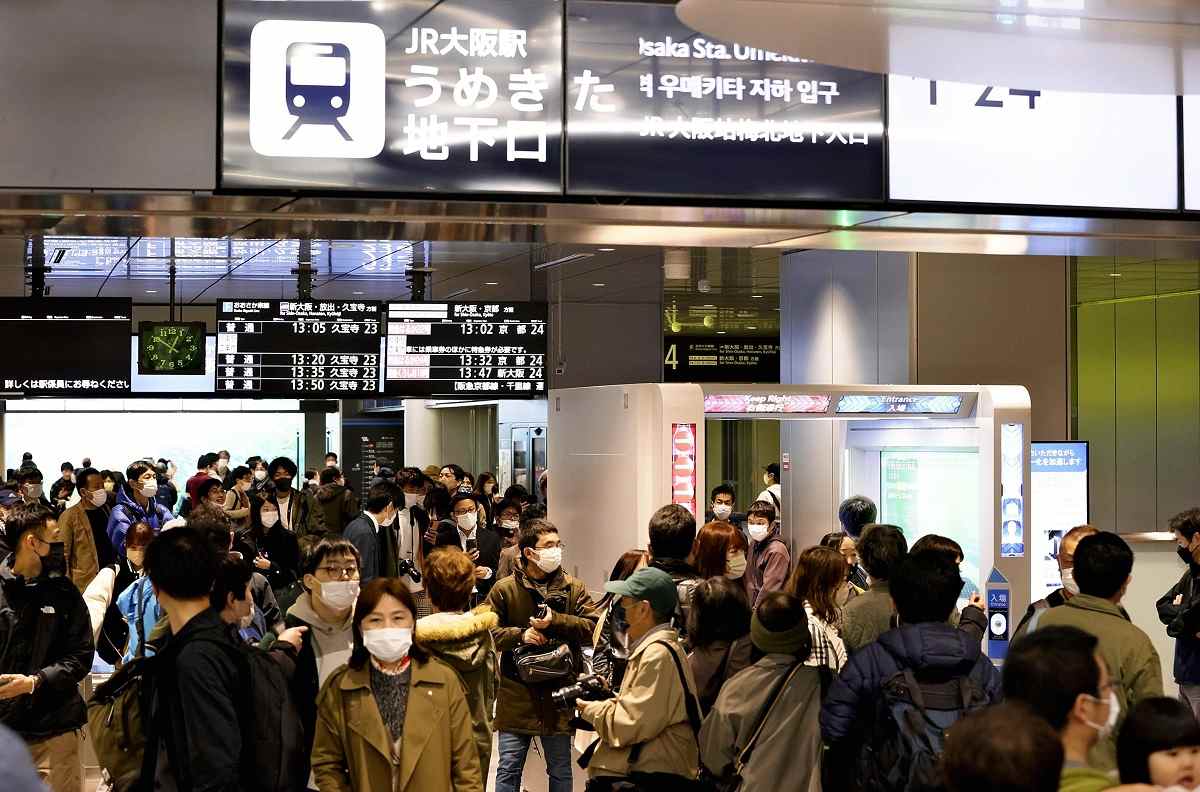
People are seen at a newly developed underground area of JR Osaka Station in Osaka on March 18.
13:23 JST, March 27, 2023
OSAKA — A newly developed underground area near JR Osaka Station is expected to further enhance the functionality of Western Japan’s largest rail terminal.
The new underground platform in the redevelopment zone north of the station is served by two limited express trains: Haruka, which connects to Kansai Airport; and Kuroshio, which heads toward Wakayama. Previously, neither of these services connected directly to Osaka Station, meaning passengers had to change at Shin-Osaka Station or Tennoji Station. With the opening of the new platform, travel times to the major travel hub have been cut by between 20 to 33 minutes on both lines.
The city of Osaka has two major downtown areas, Kita and Minami, and people have long bemoaned the lack of access to the Kita area from Kansai Airport since the latter’s opening in 1994.
With the launch of the new platform, however, it is now more convenient to travel into central Osaka from the airport, and the eastern part of Osaka Prefecture is afforded better access to the Kita district. The Osaka Higashi Line, which runs through the eastern part of the prefecture, has been extended to serve this area, allowing passengers to travel directly to Osaka Station without having to change at Shin-Osaka.
The new area connects underground to Osaka Station’s West Exit ticket gates, while above ground, the sprawling 17-hectare site — which previously hosted a freight station — continues to be redeveloped. Construction of a new 23-story station building is already underway, and it is slated to open in autumn 2024.
Naniwasuji Line
The under-development Naniwasuji Line — which will connect Kita and Minami — is scheduled to open in the spring of 2031 and serve the new underground area at Osaka Station.
West Japan Railway Co. (JR West) had originally planned to build a new station in the area, but the plan was scrapped after construction began upon approval of the Naniwasuji Line project, and it was decided to link the line’s terminal to Osaka Station via a direct passageway.
The construction of the new area at Osaka Station sits at the core of a major project involving several railroad operators. The Naniwasuji Line will be operated jointly by JR West and Nankai Electric Railway Co. and connect to both JR Namba and Nankai Shin-Imamiya stations. Hankyu Corp., meanwhile, is planning to build a connecting line from the new platform to Shin-Osaka Station.
“We’re no longer in an era where we think about competing for passengers,” a Nankai official said. “We now believe that increased convenience will lead to an across-the-board rise in the number of people using the whole railway system.”
Uncertainties remain
The new area is expected to improve Osaka Station’s functionality as a transportation bub, as it connects with the Kansai region’s air and land entrances — Kansai Airport and Shin-Osaka Station, respectively. JR West President Kazuaki Hasegawa described the new area as “Kansai’s gateway.”
Shin-Osaka Station is scheduled to serve as a terminal of the Hokuriku Shinkansen line, and is also expected to be the last stop on the Linear Chuo Shinkansen maglev line.
However, uncertainties remain about how things will play out following the opening of the Naniwasuji Line. Both the Linear Chuo Shinkansen and the Hokuriku Shinkansen extension are currently far behind schedule.
Economic activity continues to recover from the effects of the COVID-19 pandemic and the number of people visiting Japan is increasing. However, train-use figures stand at less than 90% of previous levels.
“We hope the new area won’t just be a place to board trains, but also a space that attracts various people,” Hasegawa said. JR West envisions increasing revenues by offering new technologies and services linked to the redevelopment of the new Osaka Station area, thereby stimulating the flow of people in and around the station and encouraging railroad use.
“The new Osaka Station area will further boost the Kita area, but if the gap widens between it and other areas in Kansai region, it could negatively impact Osaka and the region as a whole,” said Atsuhito Wakabayashi, a researcher at the Japan Research Institute.
"Business" POPULAR ARTICLE
-

Keidanren Chairman Yoshinobu Tsutsui Visits Kashiwazaki-Kariwa Nuclear Power Plant; Inspects New Emergency Safety System
-

Imports of Rare Earths from China Facing Delays, May Be Caused by Deterioration of Japan-China Relations
-

University of Tokyo Professor Discusses Japanese Economic Security in Interview Ahead of Forum
-

Tokyo Economic Security Forum to Hold Inaugural Meeting Amid Tense Global Environment
-

Japan Pulls out of Vietnam Nuclear Project, Complicating Hanoi’s Power Plans
JN ACCESS RANKING
-

Keidanren Chairman Yoshinobu Tsutsui Visits Kashiwazaki-Kariwa Nuclear Power Plant; Inspects New Emergency Safety System
-

Imports of Rare Earths from China Facing Delays, May Be Caused by Deterioration of Japan-China Relations
-

University of Tokyo Professor Discusses Japanese Economic Security in Interview Ahead of Forum
-

Tokyo Economic Security Forum to Hold Inaugural Meeting Amid Tense Global Environment
-

Japan Pulls out of Vietnam Nuclear Project, Complicating Hanoi’s Power Plans

























